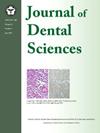Evaluating the impact of varying post angulations on the fracture resistance of maxillary incisors restored with polyethylene fiber posts
IF 3.1
3区 医学
Q1 DENTISTRY, ORAL SURGERY & MEDICINE
引用次数: 0
Abstract
Background/purpose
Restoring anterior teeth requiring angulation correction remains clinically challenging. Polyethylene fiber posts have been introduced, offering superior adaptability within the root canal and improved aesthetics. However, the effect of varying degrees of post angulation on the fracture resistance of restored teeth has not been thoroughly investigated. This study aimed to evaluate the fracture resistance of maxillary incisors restored using polyethylene fiber posts at varying angulations.
Materials and methods
Thirty-two extracted incisors were selected according to the study criteria. Root canal treatment and gutta-percha removal were performed to prepare for polyethylene fiber posts. All study samples were subsequently divided into four groups of angulations: P1 (5°), P2 (10°), P3 (15°), and a control group (0°). Fracture resistance was tested, and the data were analyzed using one-way ANOVA followed by Post-Hoc comparison with the least significant difference (LSD) statistical tests.
Results
A statistically significant difference in fracture resistance was observed among the groups, with group P1 demonstrating the highest fracture resistance (281.29 ± 84.97 N) and the control group exhibiting the lowest (164.75 ± 41.75 N).
Conclusion
There was a difference in the fracture resistance of the maxillary incisors when using polyethylene fiber posts at angulation degrees of 5° and 0°, and angulation degrees of 5° and 15°. Therefore, anterior tooth restoration with angulation correction of 5°–10° can utilize polyethylene fiber posts.
评价不同桩角对聚乙烯纤维桩修复上颌门牙抗折性的影响
背景/目的在临床上,需要矫正成角的前牙的修复仍然具有挑战性。聚乙烯纤维桩已经被引入,在根管内提供优越的适应性和改进的美学。然而,不同程度的后角对修复牙抗折性的影响尚未得到深入的研究。本研究旨在评估不同角度聚乙烯纤维桩修复上颌门牙的抗骨折性。材料与方法按照研究标准选择32颗拔牙。根管治疗和去除杜仲胶为聚乙烯纤维桩做准备。随后将所有研究样本分为四组:P1(5°)、P2(10°)、P3(15°)和对照组(0°)。对断裂抗力进行测试,并使用单因素方差分析(one-way ANOVA)对数据进行分析,然后使用最小显著差异(least significant difference, LSD)统计检验进行事后比较。结果各组间骨折阻力差异有统计学意义,P1组骨折阻力最高(281.29±84.97 N),对照组骨折阻力最低(164.75±41.75 N)。结论聚乙烯纤维桩在5°、0°角度和5°、15°角度下对上颌切牙的抗骨折性有差异。因此,5°-10°角度矫正的前牙修复可以使用聚乙烯纤维桩。
本文章由计算机程序翻译,如有差异,请以英文原文为准。
求助全文
约1分钟内获得全文
求助全文
来源期刊

Journal of Dental Sciences
医学-牙科与口腔外科
CiteScore
5.10
自引率
14.30%
发文量
348
审稿时长
6 days
期刊介绍:
he Journal of Dental Sciences (JDS), published quarterly, is the official and open access publication of the Association for Dental Sciences of the Republic of China (ADS-ROC). The precedent journal of the JDS is the Chinese Dental Journal (CDJ) which had already been covered by MEDLINE in 1988. As the CDJ continued to prove its importance in the region, the ADS-ROC decided to move to the international community by publishing an English journal. Hence, the birth of the JDS in 2006. The JDS is indexed in the SCI Expanded since 2008. It is also indexed in Scopus, and EMCare, ScienceDirect, SIIC Data Bases.
The topics covered by the JDS include all fields of basic and clinical dentistry. Some manuscripts focusing on the study of certain endemic diseases such as dental caries and periodontal diseases in particular regions of any country as well as oral pre-cancers, oral cancers, and oral submucous fibrosis related to betel nut chewing habit are also considered for publication. Besides, the JDS also publishes articles about the efficacy of a new treatment modality on oral verrucous hyperplasia or early oral squamous cell carcinoma.
 求助内容:
求助内容: 应助结果提醒方式:
应助结果提醒方式:


